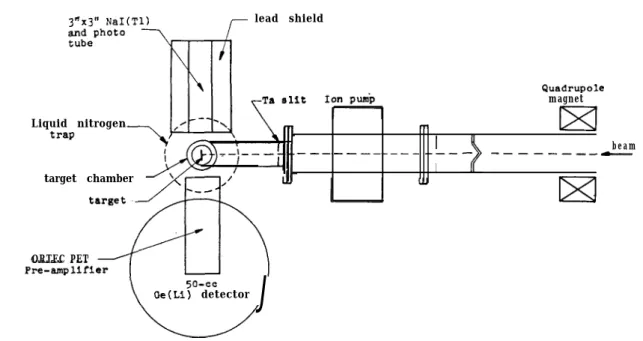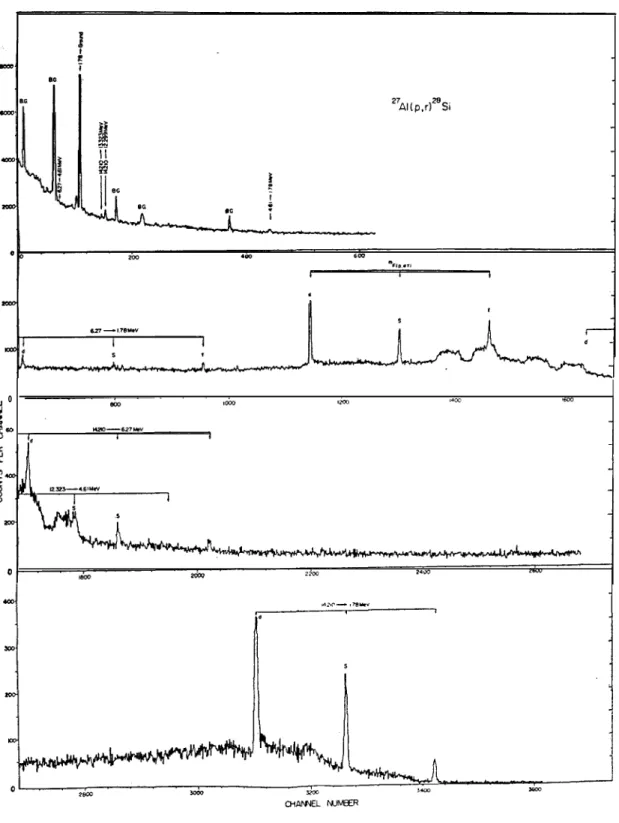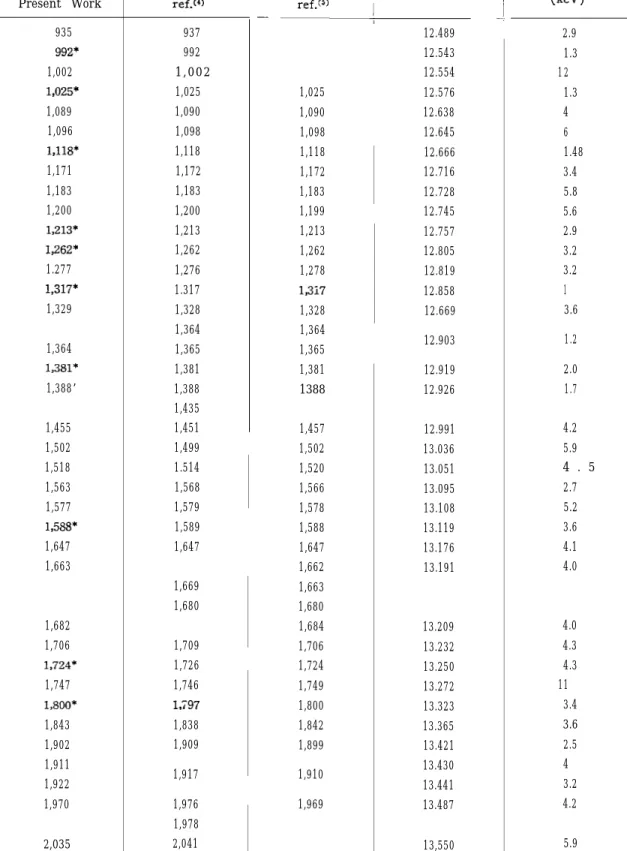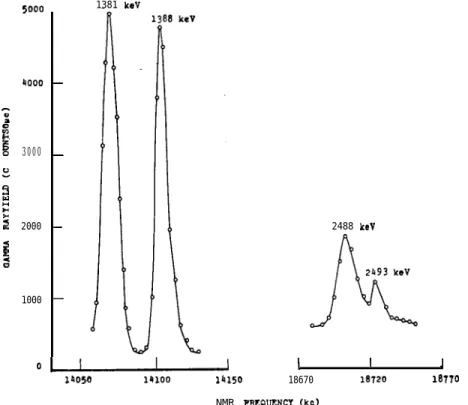CHINESE JOURNAL OF PHYSICS VOL. 10, NO. 2 OCTOBER, 1972
s
Investigation of the 27Al(p, r)Wi Reaction in the Proton Energy Range 925-2,760 KeV”
T. H. Hsu (fiA%,)**? E. K. LIN (%fi&), C. C. Hsu (k$+‘?$+,,
Y.C. LIU (@qs+), P.K. TSENG (@G&t), C. W. WANG (f&$2,), and W. S. Hsu (#&@)
Tsing Hua University, Academia Sinica and Taiwan Ukversity, Taipei
(Received 23 April 1972)
The z7Al(p,y)*aSi reaction has been studied in the proton energy range 925-2,760 keV. Seventy-four resonances were observed. Gamma-ray spectra of two new strong resonances at 2,720 and 2,748 keV, corresponding to the 14.210 and 14.237MeV levels in %i were measured by a 50-cc Ge(Li) detector., Decay schemes for these two resonance levels were proposed and branching ratios of the de-excitation of gamma-rays were determined. From arguments on transition probabilities it seems to favor a spin assignment for both resonance levels to be ]‘=3f.
1. INTRODUCTION
EN recent years, a considerable amount of spectroscopic information on a largenumber of nuclei has been obtained from the analysis of the (fi, r) reaction”‘. In particular, the “Al (p, T) ‘*Si reaction has been extensively investigated(2-6). Previously the “Al (0,
r )
“*Si experiments have been performed, mainly with proton energies from 1.0-2.0 MeV. For Eg= 0.2-1.4 MeV the results available in 1967 were summarized by Endt and Leun(‘). The excitation curves obtained show many narrow resonances corresponding to compound nuclear states of ?Si in the region of -13 MeV excitation. Among these resonances, de-excitation gamma-ray spectra from several strongly excited resonances, which populate a large number* **
(1) (2)
Work performed at the Physics Research Center and supported by the National Science Council
of the Republic of China. .
On leave from the Department of Physics, University of Ottawa, Canada.
Isospin in Nuclear Physics, ed. by D. H. Wilkinson (North-Holland Publishing Co.. Amsterdam, 1969).
Y. P. Antoufiev, L. M. En-Nadi. D. A. E. Darwish, 0. E. Badawy. and P. V. Sorokin, Nucl. Phys. 46. 1 (1963).
( 3 ) E. F. Gibson, K. Battleson, and D. K. McDaniel% Phys. Rev. 172, 1004 (1968). ( 4 ) P. B. Lyons, J. W. Toevs, and D. G. Sargood, Nucl. Phys. A130, 1 (1969). ( 5 ) M. A. Meyer, N. S. Wolmarans, and D. Eeitmann, Nucl. Phys. A144, 261 (1970). ( 6 ) S. T. Lam, A. E. Litherland, and R. E. Azuma, Can J. Phys. 49, 685 (1971j. ( 7 ) P.M. Endt and C. Van Der Leun, Nucl. Phys. A105, 1 (1967).
5 5
56 l’Ai(p. r)**Si REACTION IN THE PROTON ENERGY RANGE 925-2,760 KeV
of “Si levels, in this proton energy range have been investigated, and the in-formation on decay properties, spins and parities of the 28Si levels has been obtained.
Recently Meyer et aZ(‘), who have studied the “‘Al (fi, r)“Si reaction in the energy region E,= 1.01-2.00 MeV, have observed a new resonance at Ep= 1,683.7 keV. Lam et 0) have reported an extensive investigation on a proton resonance at Ep=1,724 keV. The resonances at proton energies above 2.0 MeV have been investigated by Gibson et aZc3), who have reported six proton resonances at energies between 1,262 keV and 2,319 keV, and by Lyons et al(“) who have made total yield measurements in the proton energy range 327--2,584 keV in an energy step of AE,=2.5 keV. The energies of strongly excited resonances observed in the “Al@, r)%i reaction have been determined to a accuracy less than 1 keV.
The present work reported herein on the “Al (fi, r) 28Si reaction was carried out in an exploratory nature. The present experiment consists of yield measure-ments for the “Al (9, T)‘~S~ reaction in the proton-energy range 925-2,760 keV and of gamma-ray spectra measurement at 2,720 keV and 2,748 keV resonances. Since we have extended this work to higher energies (Ep>2.50 MeV), more resonances have been observed, and the corresponding level energies of “Si have been accurately determined.
2. EXPERIMENTAL
The protons were accelerated by the 3.0 MeV Van de Graaff accelerator at Tsing Hua University. The beam current was 5-10 ,uA in the proton-energy range investigated. The energy resolution of the accelerator was about 1 keV for 2.5 MeV protons. The beam energy was determined by usual nuclear magnetic resonance method. The magnetic field was controlled by a current regulator unit supplied by the Spectra-Magnetic Industries, and was calibrated with several well-known resonances between 992 keV and 2,560 keV in the “Al@, r)“Si reaction”*‘).
The experimental arrangement is shown in Fig. 1. After passing through Quadrupole magnetics and collimators, the beam was focused to a fine spot on
the target. Targets were prepared by vacuum evaporation of aluminium (99.99 % )
foil onto gold backings (of -0.4 mm thick). The thickness of the prepared targets was between a few fig/cm’ and 20 /dg/cm’. In the course of the experi-ment, targets were cooled by circulating water, directly against the backings. A small target chamber was specially designed and constructed”’ for this experi-ment. Four targets can be mounted on a slowly sliding target holder driven by a small motor and they can be interchanged inside target chamber as desired
( 8) T. H. Hsu et al, to be published,
T. H. HSU et al 57
3”x3” NaI(T1) lead shield
Quadrupole magnet Liquid nitrogen ? I beam ---_--- ._-- ________-_ I target chamber l ORTEC PET 50-cc Oe(L1) detector
J
Fig. 1. Schematic view of experiment apparatus.
without breaking the vacuum. This arrangement and water cooling of the targets permitted continuously running for periods of 24 hr or longer in the gamma-ray spectra measurement without noticeable target deterioration. A liquid nitrogen cold trap was mounted near the targets to reduce contamination material buildup.
The gamma-ray were detected in a 3” x 3” NaI (Tl) crystal enclosed in a lead shield of the cylindrical shape, and also detected in a 50-cc Ge(Li) detector pur-chased from ORTEC, Oak Ridge. These two detectors were mounted oppositively at 90” to the beam direction and were placed as close as possible to the target (at a distance 4cm from the target) in order to increase the total gamma-ray counting rate. In front of both detectors, lead absorbers of -2 mm thickness were placed in order to reduce the large amount of low-energy gamma-rays caused by bremsstrahlung and Coulomb excitation in the gold backing.
For yield measurement the NaI(T1) crystal was used. After amplification the gamma-ray pulses were fed to three single channel analyzers which were set to accept pulses corresponding to photon energies 1,780 f 71 keV, 6,880 f 275 keV and above 7,500 keV, respectively. The outputs from single channel analyzers were recorded in three scalers. The electronic arrangement is shown in Fig. 2.
About thousand points were obtained for the excitation curve, covering proton energy range 925-2,760 keV. Data were taken at an energy step of hE*=l-2 keV. The integrated charges per point is 20 PC or 40 PC. Measurements were repeated at least twice for each data point in a separate day with maintaining same ele-ctronic conditions.
58 27A1(~. -y)% REACTION IN THE PROTON ENERGY RANGE 925-2.760 KeV - Pulser - Amp. SCA w SCA -Scaler B - hp. SCA 1Scaler C 50-cc Ge(LI) detectcr
Fig. 2. Block diagram of electronic circuit used in gamma-ray spectra and yield measurements.
Measurements of de-excitation gamma-ray spectra were made at two proton resonances (E,=2,720 keV and 2,748 keV) by using a 50-cc Ge(Li) detector. The energy resolution of the employed detector was 2.1 keV. The obtained gamma-ray spectra were stored simultaneously in a TMC 4,096-channel analyser and a Hewlett Packard 1,024-channel analyser. Since the measurement was carried out in a long run (24 hr) for a accumulation of charges up to 24,000 ,YC in order to get sufficient number of counts, we used two multi-channel analysers to record data for a consistent check. They were used also for the ADC linearity check and for convenience of data processing. The calibration of energies of the observed gamma-ray was based on standard-source gamma-rays, the 6,129 f 0.4 keV gamma-ray from the “F(fi, ar) r60 reaction originating from “F impurities and on the 511 keV energy difference between full-energy, single-escape, and double-escape peaks.
3. RESULT 3.1 Resonance energy and excitation function
The excitation function of the “‘AIP~, r)“Si reaction measured in the proton-energy range 925-2,760 keV is shown in Fig. 3. Fig. 3(a) shows the yields of the gamma-rays in the 1,780*71 keV region, which corresponding to the transition between the first and ground states of ?Si. The yields of 6,880 ~11275 keV gamma-rays and g.amma-gamma-rays with energies higher than 7,500 keV are shown in Figs. 3(b)
T. H. HSU et al
60 “‘Al($, y)%i REACTION IN THE PROTON ENERGY RANGE 925-2,760KeV
%
0
3”
T. H. HSU et al.
Table 1. Summary of 27Al(p,7)Z*Si yield data
-Present Work 935 992* 1,002 1,025* 1,089 1,096 1,118* 1,171 1,183 1,200 1,213* 1,262* 1.277 1,317* 1,329 1,364 1,381* 1,388’ 1,455 1,502 1,518 1,563 1,577 1,588* 1,647 1,663 1,682 1,706 1,724* 1,747 1,800* 1,843 1,902 1,911 1,922 1,970 2,035 EP (kev) ref.@) 937 992 1,002 1,025 1,090 1,098 1,118 1,172 1,183 1,200 1,213 1,262 1,276 1.317 1,328 1,364 1,365 1,381 1,388 1,435 1,451 1,499 1.514 1,568 1,579 1,589 1,647 1,669 1,680 1,709 1,726 1,746 1,797 1,838 1,909 1,917 1,976 1,978 2,041 I &X (MeV) ref.c5) 1,025 1,090 1,098 1,118 1,172 1,183 1,199 1,213 1,262 1,278 1,3i7 1,328 1,364 1,365 1,381 1388 1,457 1,502 1,520 1,566 1,578 1,588 1,647 1,662 1,663 1,680 1,684 1,706 1,724 1,749 1,800 1,842 1,899 1,910 1,969 12.489 2.9 12.543 1.3 12.554 12 12.576 1.3 12.638 4 12.645 6 12.666 1.48 12.716 3.4 12.728 5.8 12.745 5.6 12.757 2.9 12.805 3.2 12.819 3.2 12.858 1 12.669 3.6 12.903 1.2 12.919 2.0 12.926 1.7 12.991 4.2 13.036 5.9 13.051 4 . 5 13.095 2.7 13.108 5.2 13.119 3.6 13.176 4.1 13.191 4.0 13.209 4.0 13.232 4.3 13.250 4.3 13.272 11 13.323 3.4 13.365 3.6 13.421 2.5 13.430 4 13.441 3.2 13.487 4.2 13,550 5.9 61 Half Width CkeV)
62 *7Al(p,-y)*BSi REACTION IN THE PROTON ENERGY RANGE 925-2,760KeV 2,067 2,100 2,106 2,127 2,154 2159 2,162 2,172 2,183 2,205 2,222 2,238 2,289 2.306 2,315 2,334 2,360 2,374 2,404 2,415 2,449 2,488 2,493 2,522 2,537 2.541 2,554 2,583 2,593 2,612 2,641 2,683 2,720 2.729 2,733 2,748 2,054 2,067 2,084 2,106 2,114 iJ20 2,140 2,144 2,168 2,171 2,190 2,212 2,221 2,249 2,296 2512 2,320 2,334 2,365 2,375 2,407 2,447 2,481 2,489 2,522 2,537 2.560 2,584 13.561 2.4 13.612 2.9 13.618 3.0 13.638 3.4 13.664 2.5 13.669 2.5 13.672 4.9 13.682 3.7 13.692 3.7 13.713 4.2 13.730 3.5 13.746 3.2 13,794 3.8 13.811 3.3 13.820 2.5 13.838 6.3 13.663 2.6 13.877 7.7 13.905 3.3 13.916 2.1 13.949 7.8 13.987 3.7 13.991 1.6 14.b19 2.4 14.034 4.0 14.037 2.6 14.050 3.2 14.078 2.7 14.088 4.0 14.106 1.6 14.134 5.4 14.174 3.8 14.210 2.2 14.218 2.1 14.222 2.1 14.237 3.6
* Resonances were used for the energy calibration in the present work.
and 3(c), respectively. The yield curve of Fig. 3(a) shows many distinct and well-isolated resonances. There appears a total of seventy-four resonances belong-ing to the “Al(fi, r)28Si reaction. A summary of the determinations of resonance energies and widths from the present investigation is presented in Table I. AS
-T. H. HSU et al 63
can be seen in Table I, our data regarding to the resonance energies obtained in the proton-energy range 925-2,106 keV are overall in good agreement with earlier data reported by Lyons et aZC4) and Meyer et aZC5). The resonance energies given in Table I are assumed to be corrected within f 1 keV relative to the 992 keV
resonance, except some resonances which are very weak and their data are meager. At proton energies higher than 2.58 MeV, we observed several new resonances. In the proton-energy range 2,583-2,760 keV, there appears several strongly excited resonances. The relative intensity of resonances can be estimated from Fig. 3. The contribution due to gold background was found to be rather small. In the course of the experiment, background measurements were performed by bombard-ing gold foil several time over long periods. The results are shown by the dash line in Fig. 3(b),.
3.2 De-excitation of gamma-rays at 2,720 KeV and 2,748 KeV resonances
It is seen from the yield curves as shown in Fig. 3 that several distinct resonances appear at proton energies above 2.70 MeV. We have measured
gamma-,
ray spectra at two of these resonances, the 2,720 keV and 2,748 keV resonances, which corresponding to the excitation energies of ‘*Si at 14.210 MeV and 14.237 /’
MeV, respectively. There are no previous data on the decay of these two levels. The result of one of the above two measurements is shown in Fig. 4, which presents a typical gamma-ray spectrum recorded at 2,720 keV resonance. The characteristic of the spectrum is that there exhibits a prominent gamma-ray at 12.432 MeV and most of others are weaker. The observed 12.432 MeV transition indicates that the decay of resonance feeds the first excited level of ‘*Si at 1.78 MeV. Similar feature was observed in the measured gamma-ray spectrum at 2,748 keV resonance. This means that the 14.210 MeV and 14.237 MeV resonance
Table II. Relative strength of gamma-rays in the decay of
the 14.210 MeV resonance
Ex (MeV) 14.210 12.323 12.299 lOf_4 j 12.323 , 35*4 12.299 6.27 61f6 I 6.27 4.61 7f5 5+4 I 4.62 1.78 315-L31 (16) ~ 4546 13&2 g. s. I r] 1.78 397*40 ,
The errors include the statistical measurement and the uncertainty of the efficiency for Ge-detector. The number in parenthesis is taken from the previous data of Endt and Heyligers.QO)
64 *7Al(p.r)28Si REACTION IN THE PROTON ENERGY RANGE 925-2.760KeV
Table III. Relative strength of gamma-rays in the decay of the 14.237 MeV resonance
Ez (MeV) 14.237 12.323 32zt-5 I 12.323 12.173 1 0 1 2 ‘-1 1 2 . 1 7 3 11.974 15f2 I 11.974 11.898 10+2 I 11.898 6.27 29f5 I 10*3 I 6.27 4.61 13+2 / 26rt4 llf2 7f3 ’ 5&3 I 4.62 1.78 97flO 42zt6 70*11 I 1.78 g. s. j I j 21ozt21
The errors include the statistical measurement and the uncertainty of the efficiency for Ge-detector. (a) Ep = 2720 kcV (b) Ep = 2746 keV Fig. 5. 6.27 4.62 1.78
I
10 100 I 4 100 g-6.1
o+ '"Si 6.27 4.62 1.78 _ 6 1470I
90I
I’
100 tT.6.1
o* ‘“SiGamma-ray decay scheme for the levels populated in **Si at (a) the 2,720 keV resonance and (b) the 2,748 keV resonance. The number in parenthesis is taken from ref. 10.
T. H. HSU et al 65
levels decay mainly to the 1.75 MeV level.
Tables II and III show the relative strength of gamma-rays in the decay of resonant states at 14.210 MeV and 14.237 MeV, respectively. Considering the intensity of the r-1.78 MeV transition as 100 per cent, gamma-ray decay schemes for above two levels populated in “Si are proposed and presented in Figs. 5(a) and 5(b).
4. DISCUSSION
Most of proton resonances found previously have been observed in the present experiment. The doublets 1,364-1,365 keV and 1,976-1,978 keV peaks were not resolved. Several weak resonances reportedc4) by the CIT group were confirmed here, except the 1,435 keV, 2,067 keV, 2,084 keV and 2,144 keV resonances. New resonance at 1,684 keV found by Meyer et dP5) appears to be weakly excited in our measured spectra. We observed a weak resonance at 2,127 keV, while the
2,120 keV and 2,140 keV resonances as reported in ref. 4 were not observed. The weak resonances at 1,922 keV, 2,127 keV, 2,159 keV and 2,541 keV have not been previously reported. The 2,541 keV resonance was resolved from the 2,537 keV resonance.
The 1,381 keV and 1,388 keV resonances and the 2,488 keV and 2,493 keV resonances are well-resolved here. Fig. 6 show the yield curves of these resonances measured with thin target at a step of proton energy AE,=0.50 keV. The cor-responding half widths of them are 2.0 keV and 1.7 keV for the 1,381 keV and 1,388 keV resonances, and 3.7 keV and 1.6 keV for the 2,488 keV and 2,493keV resonances. The resonances found in this measurement at proton energies higher than 2,583 keV are new, the observed gamma-rays for these resonances are quite intense. In this energy region a broad peak was observed, which might consist of several resonances; we identified three resonances at 2,583 keV, 2,593 keV, and 2,612 keV. It is interesting to see from yield curve in Fig. 3(a) the steep rise at Ep above 2.70 MeV, where there appears several strong resonances. Since these resonances were also observed in the yields of gamma-rays with energies
higher than 6,SSO keV, as shown in Figs. 3(b) and 3(c), it is believed that these resonances do belong to the “‘Al(fi, r)“Si reaction.
The gamma-ray transitions for the 2,720 keV and 2,748 keV resonances, as shown in Figs. 5(a) and 5(b), were obtained from the analysis of the measured gamma-ray spectra. The numbers in Figs. 5(a) and 5(b) are the percentage of the branching ratio. These were determined with uncertainty, which includes the experimental errors and the uncertainty of the effeciency of the Ge(Li) dete-ctor, of about 12 per cent for strong transitions and about 50 per cent for weak transitions. The effeciency of the 50-cc Ge(Li) detector was taken from ref. 9.
66 *7Al(p, r)%i REACTION IN THE PROTON ENERGY RANGE 925-2.760 KeV 5000 kOO0
-”
t
i
3000 _ : 9 gw S 2000 -3 0' 1000 -1381 keV 2488 Ire.4“5i$T4r-
I I J 14150 18670 18120 lETTO NMR FR&WF.NCY (kc)Fig. 6. Yield curves for the 1,381 keV and 1,388 keV resonances, and for the 2,488 keV and 2,493 keV resonances.
Some individual discussion of the decay data follows : 4.1 The 2,720 KeV resonance
The decay from the 14.210 MeV level feeds to four lower energy levels at 12.323 MeV, 12.299 MeV, 6.27 MeV and 1.78 MeV. The r-1.78 MeV transition is predominant with a branching ratio of 75 per cent. The branching ratio for the r-6.27 MeV transition is 14 per cent. The r-+12.323 MeV and r-+12.299 MeV transitions are quite weak, the branching ratio was estimated to be about 3 per cent and 8 per cent, respectively. No ground state transition from the resonance level was observed.
The weak gamma-ray at 7.71 MeV is due to the de-excitation of the 12.323 MeV level to the 4.62 MeV level, the branching ratio for this transition was obtained to be 70 per cent which is in agreement within the experimental error with the pervious data of Endt and Heyligers(‘O). The subsequent decay from the 6.27 MeV level goes mainly to the 1.78 MeV level and partly to the 4.62 MeV level. The branching ratio was obtained to be 90 per cent for the 6.27 MeV-, 1.78 MeV transition and 10 per cent for the 6.27 MeV--+4.62 MeV transition. These
(9 ) F. C. Young, A. S. Figuera and G. Pfenfer (University of Maryland), unpublished (1970). (10) P.M. Endt and A. Heyligers, Physica 26. 230 (1960).
T. H. HSU et al 67
values agree very well with the earlier measurements by Endt and HeyligersC1’), and Jacobs and Engelbertink’“). Also, the sum of measured intensities for these two transitions is consistent with the strength of the r-t627 MeV transition.
The 4.62 MeV level decays to the 1.78 MeV level with 100 per cent of the intensity of the transitions from the resonance level to the 4.62 MeV level and from the 6.27 MeV level to the 4.62 MeV level. For the transition from the 1.78 MeV level to the ground state, the observed intensity is consistent with the sum of strengths of those transitions feeding to the 1.78 MeV level, where the branch-ing ratio for the 12.299 MeV-+1.78 MeV transition given in ref. 7 is taken into consideration.
4.2 The 2,748 HeV resonance
At the 2,748 keV resonance seven levels at 12.323 MeV, 12.173 MeV, 11.974 MeV, 11.398 MeV, 6.27MeV, 4.62MeV, and 1.78 MeV were fed from the 14.237MeV resonance level. The branching ratios for the decay of these low lying levels are given in Fig. 5(b). No ground state transition directly from the resonance
level was observed.
In the subsequent decay from the 12.323 MeV level 81 per cent of the total decay was found to feed the 4.62 MeV level. The obtained branching ratio for the 12.323 MeV+4.62 MeV transition is in agreement with the value reported by Endt and Heyligers”‘). The 12.173 MeV level decays to the 6.27 MeV with 100 per cent of the intensity of the r-+12.173 MeV transition. Although the observed gamma-rays at 5.90 MeV is rather weak, the 12.173 MeV-+6.27 MeV transition presented in ref. 7 is confirmed in the present work.
About same branching ratio (-70?4) was found for the transitions from the 11.974 MeV and 11.898 MeV to the 4.62 Mev levels. The obtained values agree fairly well with the previous data of OkanoC1’). The 6.27 MeV-+4.62 MeV transi-tion is rather weak as compared to the 6.27 MeV+1.78 MeV transitransi-tion. The intensity of the transitions feeding to the 6.27 MeV level is seen to be somewhat smaller than that of transition outgoing from the 6.27 MeV level. It is apparent that some weak transitions from highly populated levels to the 6.27 MeV level are likely missed. We were not able to observe the corresponding gamma-ray lines in the measured spectra. For the 4.62 MeV-tl.78 MeV and 1.78-g. s. transi-tions the obtained strength of gamma-ray are consistent with the decay scheme.
It is seen that the decay scheme for two resonances at E,=2,720 and 2,748 keV are somewhat similar. As discussed above, the r-1.78 MeV transition was observed about three to five times stronger than the r-12.323 MeV and r-+6.27 MeV transitions. The 1.78 MeV, 6.27 MeV and 12.323 MeV levels are known(‘) to
(11) Jacobs and Engelbertink (Utrecht), unpublished (1965). (12) Kotoyuki Okano, J. Phys. Sot. Japan 15, 28 (1960).
-.-..-A-68 “Al(p,=y)%i REACTION IN THE PROTON ENERGY RANGE 925-2,760KeV
be y=2+, 3’ and 4, respectively. From arguments on transition probabilities and taking the fact that the ground state of “‘Si is 0’ into consideration, it is favo-rable to suggust two resonance levels to be p=3+. This assignment gives a consistency in relative transition probabilities between present data and calcula-tions of Weisskopf (13). However, for the 14.237 MeV resonance, as the strengths of the r+12.323 MeV and rd6.27 MeV transitions are comparable, it may indicate that the 14.238 MeV level would be 3+ with possible higher spin admixture. In order to give a definite spin assignment, it would require a more extensive study of the “‘Al@, r)?ji reaction with angular correlation measurements.
ACKNOWLEDGMENTS
We are indebted to Prof. W. N. Wang for his support of the present work. We are also grateful to the members of the Van de Graaff accelerator laboratory at Tsing Hua University for their technical assistance.
(13) V. F. Weisskopf, in Nuclear Spectroscopy Part B. p. 860, ed. by Fay Ajzenberg-Selove (Academic Press. New York, 1960).






